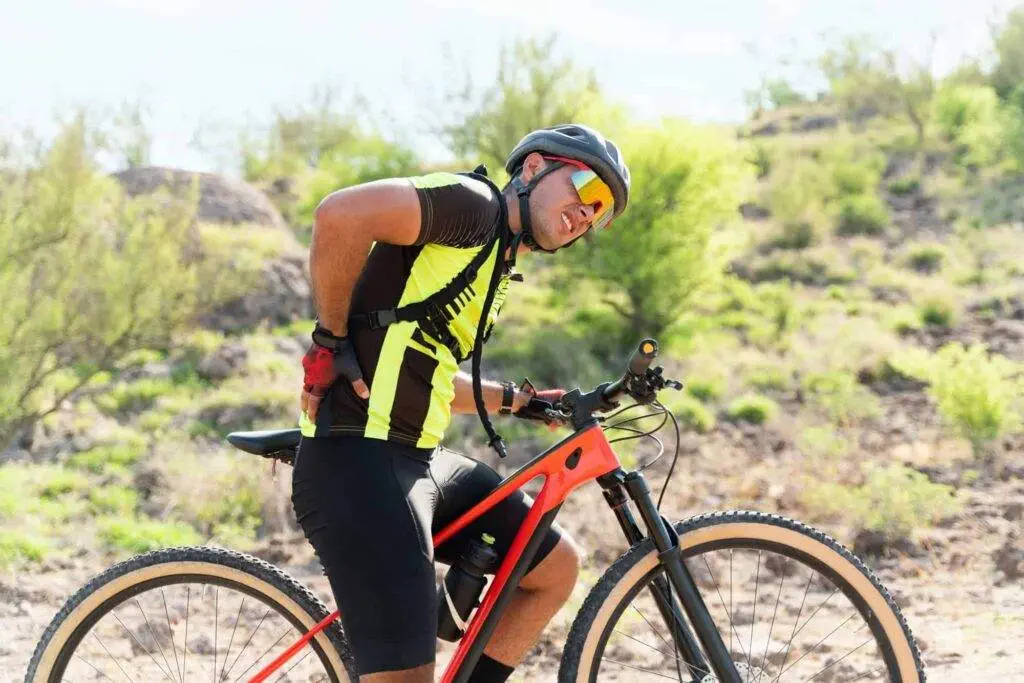Cycling is an excellent way to improve core fitness and build your lower body muscles. The last thing you want is to suffer back pain because of it.
There is always the risk of injury with cycling, but that is true of any form of exercise. This article will answer the question: is cycling bad for your back and the best ways to prevent this from happening.
Don’t let a bad back put you off this amazing activity. Keep reading to learn the best ways to strengthen your back and enjoy pain-free cycling.
Key Takeaways: Is Cycling Bad for Your Back
- Cycling is a low-impact aerobic exercise that is less jarring than other forms of exercise.
- A good bike fit is essential to minimizing the risk of back pain when cycling.
- Good posture is essential to minimize the risk of back pain when cycling.
- Cycling can help to reduce lower back pain.
- Back stretching can reduce stiffness and prepare cyclists for bike riding.

Potential Risks of Cycling for Your Back
Back pain, especially in the lower back, can occur on long-distance bike rides. It can become stiff and uncomfortable for riders that maintain a bent-over position for long periods.
The lower back is made up of ligaments, tendons, and muscles. These muscles, ligaments, and tendons create a musculature cylinder that surrounds the lumbar spine.
Bending over the handlebars can cause static flexion. If you happen to work an office job, you might recognize this from hunching over a desk.
The vibration that transfers from your seat to your lower back can also lead to sore or fatigued muscles.
An imbalance in muscle power can also lead to injury. Cycling can work the core and tone the upper body, but additional work should be carried out to ensure the upper body and core muscles can handle the power generated by the lower body.
Overuse injuries are also common causes of lower back pain for cyclists.
Plus, failure to warm up and warm down impacts muscle recovery.

Importance of Proper Bike Fit
It’s essential that you use the correct bike size and setup. Your riding position will determine your form and the muscles you engage when cycling.
Your starting position will depend on why you’re cycling. For example, using a cruiser bike to cycle around a city will have you in an upright position. Competitive cyclists require a more aerodynamic position with the rider hunched forward over their handlebars.
An angle of around 20 degrees is considered the best for the back to avoid pain. But, you must still ensure you’ve set up the seat and handlebars correctly.
Keep your knees bent slightly when you reach the lowest point of the pedal stroke. This will stop you from overreaching or having to shift your form from side to side while cycling.
A poor posture will strain your back muscles and result in a painful ride.
A neutral spine should be maintained when cycling on a road bike. This should result in a relatively straight line between the shoulders and hips.

Benefits of Cycling for Your Back
Good form and posture will help you to improve flexibility and reduce muscle tension in the lumbar region.
Other forms of exercise are typically more impact based. This is a great way to enjoy excellent aerobic and cardiovascular exercise that improves the performance of your musculoskeletal system and spine.
Tips for Preventing Back Pain While Cycling
The best ways to minimize the risk of back pain when cycling include:
Ensuring a good bike setup
Make sure the seat and handlebars are positioned correctly so you have good back posture.
Work on core stability
Cycling works your core, but additional training to strengthen your core will significantly improve lower back endurance.
Work on your hips
The body should not be seen as individual elements. It is a large system that requires balance and weaknesses in one position can affect others.
Hip mobility and musculature are important to your posture and maintaining a neutral spine.
Don’t push yourself too hard
Pushing yourself too hard too quickly can result in muscle fatigue and pain. Gradually increase your workouts and bike rides in terms of distance and difficulty.
Change positions
Moving your back and changing positions while cycling will minimize the risk of repetitive stress injuries.
Warm up and warm down
Stretch before and after cycling to ensure muscles are prepared for exercise and are wound down after.
How to Identify Back Pain While Cycling
Back pain while cycling can be identified as discomfort in some cases. In others, lower back spasms can occur.
If you start to feel back pain on either side, this could be evidence of a muscle imbalance or potential injury.
The body will naturally compensate for poor performance in certain areas by putting the workload onto others. This can lead to muscle overload and injury.

Next steps: Exercises to Strengthen Your Back and Prevent Back Pain
Exercising your back can help to loosen tight muscles and strengthen them for cycling. Some of the best back stretches for cyclists include:
- Quad couch stretches
- Prone push-up
- Cat position
- Hug stretch
- Seated upper body bend
- Downward facing dog
- Supine figure-four stretches
- Lower and upper trunk rotations
- Standing back bend
- Quadruped T-spine rotations
These exercises can be used as part of a warm-up and warm-down routine to ensure you don’t suffer from lower back pain.
FAQs
Is a recumbent bike good for your back?
A recumbent bike requires you to sit back rather than lean forward. This offers great support for your lower-back muscles and spine.
How do I stop neck pain when cycling?
Back and neck pain when cycling is closely linked. A sore neck or shoulder blades are typically caused by a poor bike fit.
Should I wear a back brace to prevent back pain when cycling?
A back brace can help to prevent injury and can also be used during recovery. A brace can also help cyclists maintain good posture and practice their form.
However, your body can become reliant on lumbar support and grow weaker over time. Cycling without the brace, when you are fully fit, will help to minimise this risk.
